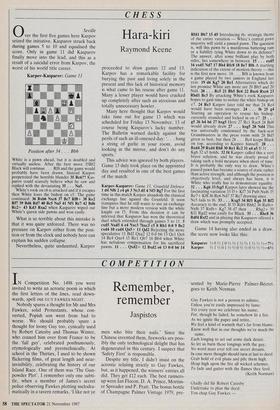CHESS
Hara-kiri
Raymond Keene
0Seville
ver the first five games here Karpov seized the initiative. Kasparov struck back during games 5 to 10 and equalised the score. Only in game 11 did Kasparov finally move into the lead, and this as a result of a suicidal error from Karpov, the worst of his world title career.
Karpov-Kasparov: Game 11
Position after 34. . . Bb6
White is a pawn ahead, but it is doubled and virtually useless. After the best move 35Bf2 Black will continue. . . R18 and the game would probably have been drawn. Instead Karpov perpetrated the horrible blunder 35 Rc6?? Kas- parov could scarcely believe what he saw and replied with the devastating 35. . . Na5.
White's rook on c6 is attacked and if it escapes then White loses the bishop on c5. The game continued 36 Bxb6 Nxc6 37 Bc7 Rf8+ 38 Ke2 Rf7 39 8d6 Rd7 40 Bc5 Na5 41 Nfl Rc7 42 Bd6 Rc2+ 43 Kd3 Rxa2 when Kasparov wiped out White's queen side pawns and won easily.
What is so terrible about this mistake is that it was quite unforced. There was no pressure on Karpov either from the posi- tion or from the clock and nobody here can explain his sudden collapse.
Nevertheless, quite undaunted, Karpov proceeded to draw games 12 and 13. Karpov has a remarkable facility for burying the past and living solely in the present and this lack of historical memory is what came to his rescue after game 11. Many a lesser player would have cracked up completely after such an atrocious and totally unnecessary howler.
Many here thought that Karpov would take time out for game 13 which was scheduled for Friday 13 November, 13 of course being Kasparov's lucky number. The Bulletin warned darkly against the perils of such an ill-omened day: . . hang a string of garlic in your room, avoid looking in the mirror, and don't do any sports.'
This advice was ignored by both players. Game 13 duly took place on the appointed day and resulted in one of the best games of the match: Karpov-Kasparov: Game 13, Grunfeld Defence 1 d4 Nf6 2 c4 g6 3 Nc3 d5 4 Nf3 Bg7 For the first time in this match Karpov abandons the classical exchange line against the Grunfeld. It soon transpires that he still wants to use an exchange line but a more modern version with the white knight on f3. From this decision it can be inferred that Kasparov has won the theoretical duel which extended through games 5 to 11. 5 cxd5 Nxd5 6 e4 Nxc3 7bxc3 c5 8 Rbl 0-0 9 Be2 cxd4 10 cxd4 Qa5+ 11 Qd2 Rejecting the more speculative 11 Bd2 Qxa2 12 0-0 b6 13 Qc1 0e6 14 Bc4 Oxe4 15 Re! Qb7 16 Bb4 when White has nebulous compensation for his sacrificed pawns. 11 . . . Qxd2+ 12 Bxd2 e6 13 0-0 b6 14
Rfdl Bb7 15 d5 Introducing the strategic theme of the entire variation — While's central pawn majority will yield a passed pawn. The question is, will this pawn be a murderous battering ram or a liability tying White down to its defence? The answer, after some brilliant play by both sides, lies somewhere in between. 15 . . . exd5 16 exd5 Nd7 17 Bb4 Rfc8 18 Be7 Bf6 A startling indication of the extent of modern theory — this is the first new move. 18. . . Bf8 is known from a game played by two juniors in England last year. 19 d6 Kg7 20 Rd l Alternatives which do not promise White any more are 20 Bb5 and 20 Nd4. 20 . . . Rc5 21 Bb5 Bc6 22 Bxc6 Rxc6 23 Rbdl Bc3 By attacking White's rook Kasparov hopes to gain time to isolate the white bishop on e7. 24 Re3 Karpov later told me that 24 Re4 would have been stronger. 24 . . . f6 25 g4 Starting an operation to rescue his bishop. currently stranded and locked in on e7. 25 . . . g5 26 h4 h6 27 hxg5 Here 27 Rd l Rac8 28 Bd8 would already draw 27 . . . hxg5 28 Nd4 This was universally condemned by the back-seat Grandmasters in the press room with 28 Bd5 given as best, but then 28 . . Rc4 keeps Black on top, according to Karpov himself. 28 . . . Bxd4 29 Rxd4 Rh8 30 Rel Rc2 31 a4 a5 If 31 . . Kg6 32 a5 holds. 32 f4 Karpov called this a very brave solution, and he was clearly proud of taking such a bold measure when short of time. It is probably the only way to draw. White's passed pawn has become a source of static rather than active strength, and although the position is objectively level, and always has been, it is White who really has to demonstrate equality. 32. . . Kg6 33 fxg5 Karpov later showed me the fascinating variation 33 f5+ KG 34 Pxf6 Nxf6 35 Re7+ Kf8 36 Re6 Nd7 37 Re7 drawing since. . . Nc5 fails to f6. 33. . . Kxg5 34 Rfl Kg6 35 Rf2 Accuracy to the end. If 35 Rdf4 Rhh2 36 Rxf6+ Nxf6 37 Rxf6+ Kg7 38 d7 then . . . Rhg2+ 39 Kf1 Rgd2 wins easily for Black. 35. . . Rhc8 36 Rdf4 Rxf2 and in playing this Kasparov offered a draw which was promptly accepted.
Game 14 having also ended in a draw, the score now looks like this:
Kasparov 1/2 0 1/2 1 0 1/2 1/2 1 1/2 1/2 1 1/2 1/2 1/2=71/2 Karpov 1/2 1 1/2 0 1 1/2 1/2 0 1/2 1/2 0 1/2 1/2 1/2=61/2


































































 Previous page
Previous page